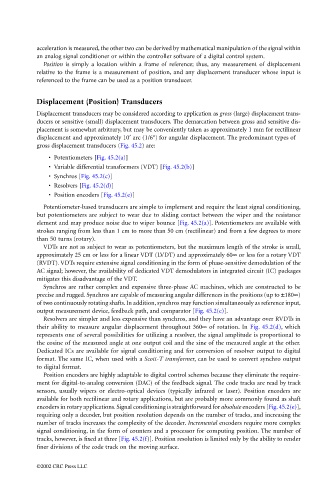Page 1164 - The Mechatronics Handbook
P. 1164
acceleration is measured, the other two can be derived by mathematical manipulation of the signal within
an analog signal conditioner or within the controller software of a digital control system.
Position is simply a location within a frame of reference; thus, any measurement of displacement
relative to the frame is a measurement of position, and any displacement transducer whose input is
referenced to the frame can be used as a position transducer.
Displacement (Position) Transducers
Displacement transducers may be considered according to application as gross (large) displacement trans-
ducers or sensitive (small) displacement transducers. The demarcation between gross and sensitive dis-
placement is somewhat arbitrary, but may be conveniently taken as approximately 1 mm for rectilinear
displacement and approximately 10′ arc (1/6°) for angular displacement. The predominant types of
gross displacement transducers (Fig. 45.2) are:
• Potentiometers [Fig. 45.2(a)]
• Variable differential transformers (VDT) [Fig. 45.2(b)]
• Synchros [Fig. 45.2(c)]
• Resolvers [Fig. 45.2(d)]
• Position encoders [Fig. 45.2(e)]
Potentiometer-based transducers are simple to implement and require the least signal conditioning,
but potentiometers are subject to wear due to sliding contact between the wiper and the resistance
element and may produce noise due to wiper bounce [Fig. 45.2(a)]. Potentiometers are available with
strokes ranging from less than 1 cm to more than 50 cm (rectilinear) and from a few degrees to more
than 50 turns (rotary).
VDTs are not as subject to wear as potentiometers, but the maximum length of the stroke is small,
approximately 25 cm or less for a linear VDT (LVDT) and approximately 60∞ or less for a rotary VDT
(RVDT). VDTs require extensive signal conditioning in the form of phase-sensitive demodulation of the
AC signal; however, the availability of dedicated VDT demodulators in integrated circuit (IC) packages
mitigates this disadvantage of the VDT.
Synchros are rather complex and expensive three-phase AC machines, which are constructed to be
precise and rugged. Synchros are capable of measuring angular differences in the positions (up to ±180∞)
of two continuously rotating shafts. In addition, synchros may function simultaneously as reference input,
output measurement device, feedback path, and comparator [Fig. 45.2(c)].
Resolvers are simpler and less expensive than synchros, and they have an advantage over RVDTs in
their ability to measure angular displacement throughout 360∞ of rotation. In Fig. 45.2(d), which
represents one of several possibilities for utilizing a resolver, the signal amplitude is proportional to
the cosine of the measured angle at one output coil and the sine of the measured angle at the other.
Dedicated ICs are available for signal conditioning and for conversion of resolver output to digital
format. The same IC, when used with a Scott-T transformer, can be used to convert synchro output
to digital format.
Position encoders are highly adaptable to digital control schemes because they eliminate the require-
ment for digital-to-analog conversion (DAC) of the feedback signal. The code tracks are read by track
sensors, usually wipers or electro-optical devices (typically infrared or laser). Position encoders are
available for both rectilinear and rotary applications, but are probably more commonly found as shaft
encoders in rotary applications. Signal conditioning is straightforward for absolute encoders [Fig. 45.2(e)],
requiring only a decoder, but position resolution depends on the number of tracks, and increasing the
number of tracks increases the complexity of the decoder. Incremental encoders require more complex
signal conditioning, in the form of counters and a processor for computing position. The number of
tracks, however, is fixed at three [Fig. 45.2(f)]. Position resolution is limited only by the ability to render
finer divisions of the code track on the moving surface.
©2002 CRC Press LLC

